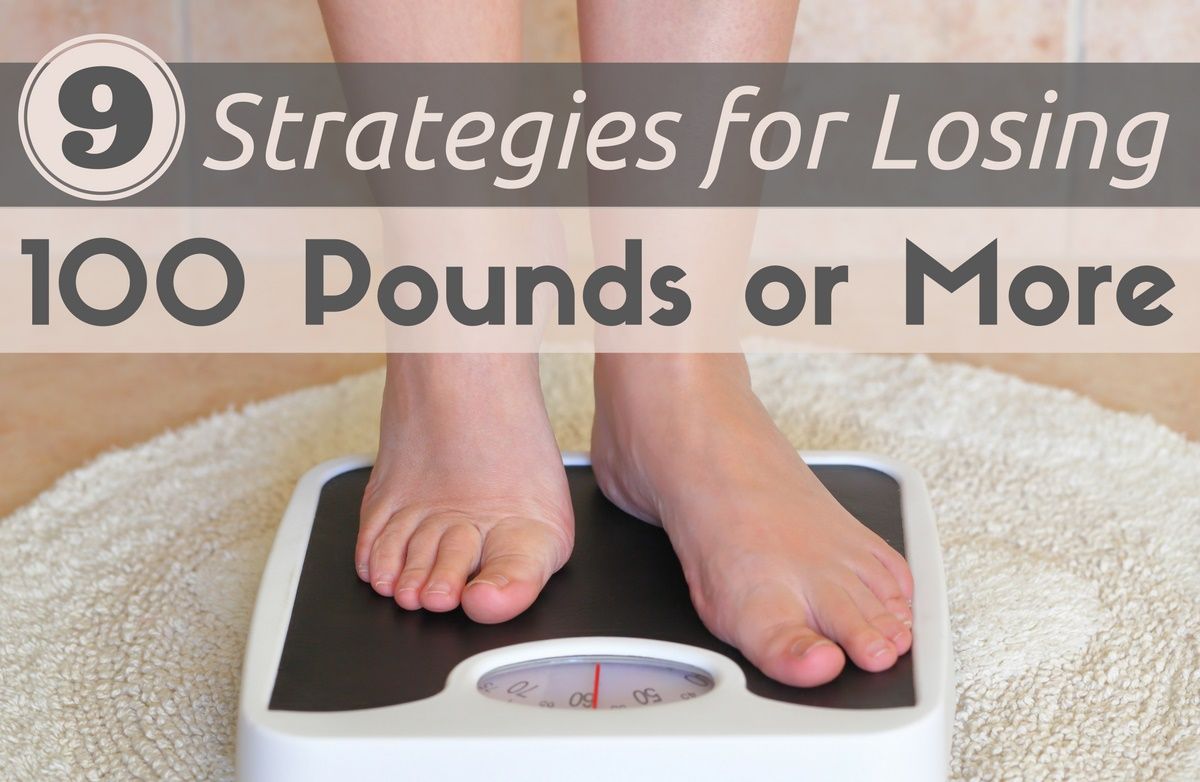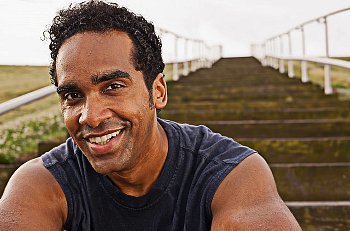Lose Weight > Common Sense To Lose Weight > Common Sense Article > Where to Start if You Have 100+ Pounds to Lose
Where to Start if You Have 100+ Pounds to Lose
 More than half of Americans—56 percent—are trying to lose weight. While there may be some comfort in numbers on the path to weight loss, the length and difficulty of that path is unique for each person. The woman who wants to lose 10 pounds for her daughter's wedding, for example, probably doesn't fully grasp the struggle of the diabetic whose doctor has advised him to shed half his body weight for his health.
More than half of Americans—56 percent—are trying to lose weight. While there may be some comfort in numbers on the path to weight loss, the length and difficulty of that path is unique for each person. The woman who wants to lose 10 pounds for her daughter's wedding, for example, probably doesn't fully grasp the struggle of the diabetic whose doctor has advised him to shed half his body weight for his health.If you need to lose a large amount of weight—100 pounds or more—you likely have a mix of feelings. On one hand, you're motivated and determined to reach your goal; on the other, you’re overwhelmed and facing many perplexing questions. Where should you start? How long will the process take? Do you really have the patience and staying power to stick with it for the months and years ahead?
"Weight-loss always requires the right mindset, especially when one has over 100 pounds to lose," says personal trainer and nutritionist Kristy Stabler. "We all love quick fixes, but this journey requires a long-term approach, focusing on accomplishing daily healthy behaviors rather than an outcome like scale weight.”
By adhering to some smart strategies for diet, exercise and outlook, you'll be well on your way to losing the weight, and gaining some valuable confidence and life lessons along the way.
Talk to your doctor.
There’s no magic prescription that will melt the pounds away, but that doesn’t mean your doctor shouldn’t play a role in your journey. Particularly if your plan is to achieve triple-digit weight loss, it’s always a good idea to speak with your primary care physician first. He or she can answer your questions about diet, exercise and medications, and can help you to set realistic goals and tailor your fitness regimen to your medical history and health conditions.
Start by focusing on diet.
Anyone who has lost a significant amount of weight knows it's not possible to exercise away a bad diet. According to Stabler, diet should be the first focus. "Getting your nutrition right will drop the body fat faster than any workout at this point," she says. "Consuming less sugar while increasing your vegetable and fruit intake will help you get started. Next, cut out fried foods like French fries, chicken nuggets and corn dogs."You don't have to skip meals or deprive yourself of all the foods you love. In fact, if you consume too few calories, your body will go into "starvation mode" and your metabolism could actually slow down.
Fitness trainer Cheryl Russo suggests looking for ways to make smart, easy swaps. For example, if you drink sugar-sweetened carbonated soda, substitute seltzer with a splash of juice. If you love fried potato chips, switch to pretzels or veggie chips. Look for baked versions of any fried foods you normally eat. Planning ahead and planning smart is key. "If you're on the go all day, make sure to pack healthy, pre-portioned snacks, like rice cakes with nut butter, mixed nuts and dried fruit, banana or a small amount of cubed cheese and apple," Russo recommends.
Know how much you're eating.
Mindless eating and snacking is a key culprit in calorie overconsumption. To find out how much you eat in a typical day, start logging your food in a tracking app, such as SparkPeople Mobile. "Once you've determined your 'normal' range, look for ways to reduce calories in your daily diet, but resist the urge to slash calories super low to drop weight faster," says Stabler. "Doing that might work short-term, but it will also crash your energy and make the whole experience miserable."Tyler Spraul, Certified Strength and Conditioning Specialist for Exercise.com, recommends a simple formula to calculate how many calories are required to maintain your current weight: 14 to 16 times your bodyweight in pounds. "Once you've determined your maintenance number, you can start decreasing your daily intake by 500 to 1,000 calories, which will set you up to lose one or two pounds per week," he says.
Start with low-intensity exercise.
High-intensity workouts can be risky at the outset of a long weight-loss journey. "People who have a lot of weight to lose have more force putting extra pressure on the joints, which can make them more susceptible to injury," warns trainer Brooke Taylor, owner of Taylored Fitness. "Start by setting small, attainable goals each week to build endurance and strength." Low-impact exercises—such as walking, swimming, yoga and the elliptical—put less force on the body and joints, decreasing the chance of injury.The key is consistency, says Spraul. "You have to plan the time and carry out your plan, every day," he says. "You can start with a 10-minute walk, and then work your way to up 20 or 30 minutes per day. This will lay the groundwork for a regular workout routine." Once you've made the walking a daily habit, you can start sprinkling in more activities, such as running, biking, swimming, sports or going to the gym.
Don't rush it.
ACE-certified personal trainer Shane McLean is a firm believer that slow and steady wins the weight-loss race. "Too often, people rush into an exercise routine and try to undo years of damage in a few short workouts," he says. "When they don't get results, or get too sore or injured, they may quit and fall into the stop-start spiral. Think like the tortoise, not the hare."In fact, Spraul points out that losing too much weight in a short amount of time can actually backfire. "Losing more than one percent of your bodyweight per week can negatively affect your hydration, vitamin and mineral levels," he says. "Making small progress over longer periods of time helps you preserve muscle mass and lose primarily fatty tissue." A gradual change will also be more sustainable in the long term, increasing the chances of keeping the weight off once you reach your target.
Stop calling it "exercise."
While you probably wouldn't spend all that time sweating in spin class if it didn't burn hundreds of calories, the experts recommend not thinking of exercise as merely a calorie burner. In fact, personal trainer Dani Singer recommends calling it "activity" instead of "exercise." "Do whatever activities you enjoy—biking, soccer, swing dancing—and don't ruin the fun by calling it a workout," he says.Beyond burning calories, exercise plays a big role in boosting your mood, which has its own indirect weight-loss benefits. "When you get your blood pumping, your body releases endorphins, which make you feel good," explains Singer. "And when you feel good, you eat better, and everything else starts falling into place."
Stand up for weight loss.
Even for those who carve out an hour for exercise, a majority of the day is typically spent sitting. One study revealed significant weight-loss benefits for people who stood for at least three hours a day. Over the course of a year, the participants burned over 30,000 calories, or the equivalent to eight pounds of fat. To incorporate a change in your life, try to work standing into your daily activities at work or with friends and family. Swap a happy hour sitting at the bar with a walk around the park, or see if your boss will let you invest in a standing desk to break up the long hours sitting at your computer. Even just setting a reminder for yourself to stand up and walk to the break room or to talk to a coworker makes a difference.Bringing that same attitude to the gym can be hugely beneficial to your health, too. "Standing while exercising will also improve core strength and balance," says McLean. "To reap those benefits, try to do most of your exercise routine standing up."
Sprinkle in some strength training.
Once your body has adjusted to two weeks of low-intensity cardio workouts, add a couple days of strength training. "Building more muscle mass raises the metabolism, builds lean body mass and burns more fat," says Russo.Feeling wary about weights? Consider finding a certified personal trainer to help you feel more comfortable in the gym, show you some basic resistance-training moves and help to prevent injury. "Again, we’re not looking for anything super high intensity," says Stabler. "Some weight training will simply provide the right hormonal response to help you keep dropping body fat and prevent muscle loss."
Taylor suggests alternating between functional training movements and some cable machines. "Your heart rate will elevate quicker, so try working in both standing and sitting positions to aid in recovery in between exercises," she says.
Not sure where to start? Taylor recommends this sample strength training workout:
- 10-minute warm up (walking, jogging or cycling)
- Seated cable chest fly
- Squat-to-row exercise
- Seated leg press
- Lateral tube band walks
- Crunches with feet on the ground
- Lateral leg lifts
- Quadruped swimming
- Seated dumbbell bicep curls
- Standing tricep rope extension
- Bridges on the floor
Track your progress in black and white.
Just as the weight was gained little by little, its disappearance will be gradual. You might not notice overnight changes, but after a week, month or year, you'll be amazed by how far you've come since day one.To help determine if your efforts are working, Stabler suggests writing down your weight and waist measurements, or taking some pictures for visual comparison. "This isn't meant to be a way to shame yourself about where you’re starting from," she adds. "You’ve made a decision to improve your health, and these measurements are merely feedback to make sure you’re taking care of yourself properly."
Monitoring and celebrating small victories, such as your clothes fitting better, being able to walk a mile without getting winded or noticing some definition in your arms for the first time, will keep you motivated and inspired throughout your journey. It’s important to give yourself a round of applause every so often.
Make your new habits stick.
As you start to drop weight, the key to maintaining the momentum is adhering to your new healthy habits for the long term. According to Stabler, it's all about finding ways to engage: build friendships with other people who work out regularly, take cooking lessons that teach you how to make healthy food taste delicious or join a group of friends who like to hike every weekend. On the flip side, you may decide to spend less time with friends who engage in the activities that led to your weight gain in the first place."Building the right environment for success is a smart move to increase your accountability and consistency," says Stabler.
Shedding more than 100 pounds can seem like a losing battle, but a positive outlook, some smart strategies and a strong support system can bring even the biggest weight-loss goals within reach.
Related Articles
-
Dieting - Meant for Teens?
Teen Dieting We have the highest teenag
-
Take Back Your Temple How To Win Your Weight Loss Battles For Good
Even though Ive never met you, I think I know something about you. You
-
The Low GI Diet: Eat Your Favorite Foods and Normalize Your Blood Sugar
There is an increasingly popular family of diets, which use the gly
-
Weight Loss - How to Control Night Hunger
Understanding a problem is the first step to solving it. When it c
-
Losing Weight Without Diets
Technically talking, shedding pounds is uncomplicated — just cut
-
A Great Abs Diet for Women
Every woman appreciated the advantage of being attractive. Attracti
- DON'T MISS
- Lose Extra Pounds With The Strongest Fat Burners To Get A Sleek Body
- An Interview With An Emotional Eater
- Shed the excess weight making use of various Wholesome diet plans that operate – Weight-loss
- Where To Get Personal Training For Weight Loss ?
- Cereals – A Healthy Food
- Dr. Dion Presents: The Top 5 Causes of Childhood Obesity Epidemic
- Two Tips To Increase Your Chances Of Losing Weight
- 6 Tips To Choosing A Diet You Wont Give Up On
- Tummy Tuck Scars Are Simply A Trivial Drawback After Cosmetic surgery – Don’t Allow It To Dispirit You
- Energy And Weight Loss Products Put Your Training On Track




